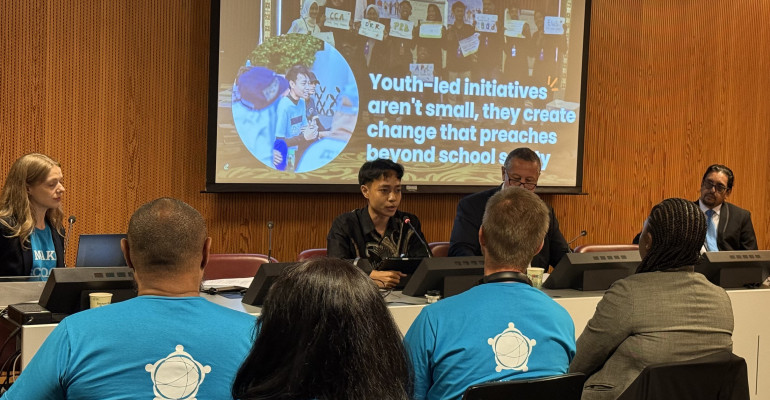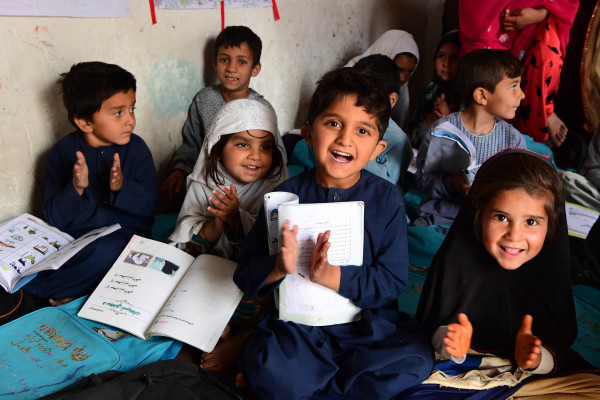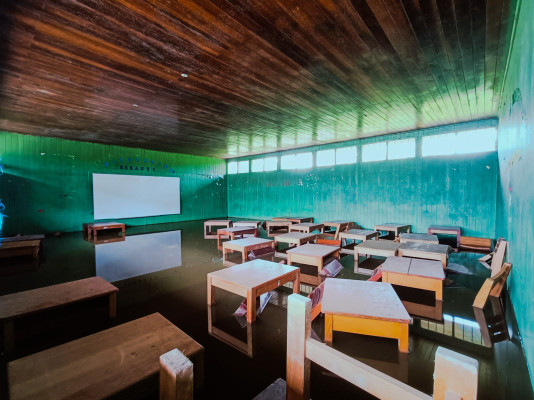What happened for education at the Global Platform for Disaster Risk Reduction 2025?
Even as the dust was hardly settled over the village of Blatten, representatives from across countries and sectors descended on another part of Switzerland to discuss protection of people and communities from future crises.
The Global Platform for Disaster Risk Reduction (GP2025), co-hosted by the UN Office for Disaster Risk Reduction (UNDRR) and the Government of Switzerland, was held in Geneva from 2 to 6 June. Thousands of delegates from the Caribbean to Comoros to the Cook Islands came together to act for resilience today – the theme of the Platform.
With thanks to the championing efforts of the co-hosts, one topic emerged as a clear focus: safe schools.
Here are four things we learned about safe schools at GP2025.
1. Global evidence shows the urgent need for accelerated action.
The annual impact of disasters on education is catastrophic. Research from UNDRR released immediately before the Platform highlights that disasters cost education systems an annual average loss of $35.9 billion.
The key findings from the Comprehensive School Safety Policy Survey 2024 add a more human dimension to this financial loss. Governments in the survey recognised a wide range of hazards impacting education systems, with nearly nine in 10 governments highlighting health, bullying and violence, and climate change impacts as affecting schools.
However, responses are not as widespread as the impacts demand. With just 12% of governments reporting systematically funded upgrades of school buildings; nearly half of governments stating educational continuity guidance was limited, poorly distributed, or poorly understood; and less than one in five governments mandating teacher training on Disaster Risk Reduction, the need for scaled up action across the pillars of the Comprehensive School Safety Framework is clear.
What is the Comprehensive School Safety Framework?
The Comprehensive School Safety Framework is an evidence-based approach to protecting children and education systems from a range of crises and disasters.
The Framework includes recommendations, roles, and responsibilities for all aspects of school safety, covering three pillars:
- Pillar 1: Safer learning facilities, to strengthen the resilience of education systems.
- Pillar 2: School safety and education continuity management, to keep schools open and children learning in times of crisis.
- Pillar 3: Risk reduction and resilience education, to provide children with the skills, knowledge and behaviours to prepare for and respond to shocks and stresses.
These pillars are connected to existing education and Disaster Risk Reduction approaches through enabling systems and policies, also defined in the Framework.
Importantly, the Framework adopts an all-hazards, all-risks approach, reflecting the reality of many countries and making it relevant for a wide range of everyday risks, disasters and the compounding effect of multiple crises.

2. Governments are acting for resilient education, but ambition should be scaled up.
Despite a packed agenda, governments prioritised sharing their school safety initiatives at a Ministerial Roundtable on Safe Schools, held as part of GP2025. Over 35 governments set out statements on the impact of disasters on education systems and the need to scale up action. Several statements included direct reference to the Comprehensive School Safety Framework.
Despite a strong display from governments, there remains a need to scale up ambition for safe schools across the globe. Wide ranging and compounding hazards, with their wide ranging and compounding impacts, demand more ambitious commitments to make every school safe.
Importantly, these commitments must be driven, implemented, and monitored in partnership with ministries of education. With interventions largely coming from national disaster management authorities, discussion fell in favour of infrastructure and less on other aspects of safe schools such as contingency planning, anticipatory action, teacher training, and curriculum integration. Meaningful and deliberate cross-sectoral action and strong coordination with local governments are essential to implement all aspects of safe schools.
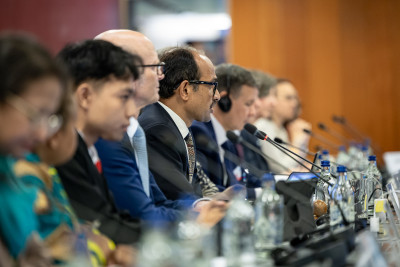
Mr Kamal Kishore, Head of the UN Office for Disaster Risk Reduction, and other delegates at the Ministerial Roundtable on Safe Schools. Image credit: Antoine Tardy for UNDRR
3. Practical solutions are changing children’s lives across the globe.
Across the Platform, practical action for safe schools was on show.
Government representatives from Saint Lucia, Kyrgyz Republic, and Tonga spoke of national and regional efforts to deliver safe schools during the GADRRRES side event, titled Inclusive Comprehensive School Safety: Strengthening Resilience for Children and Youth in all hazards.
This side event also platformed tangible stories and tools from GADRRRES members, including UNICEF, UNESCO, the International Federation of the Red Cross and Red Crescent, the Inter-Agency Network for Education in Emergencies (INEE), Save the Children, and Plan International. These resources and case studies, all built on the Comprehensive School Safety Framework, demonstrate how organisations are keeping children safe and learning across the globe.
In addition to the side event, the National Disaster Management Authority of Pakistan, Plan International, Save the Children, GADRRRES, and others took to the Ignite Stage to showcase even more examples of action for safe and resilient education. And at the Innovation Platform, VR technology, adolescent-focussed games, and books for children were on display, showing how to bring Disaster Risk Reduction to life for children.
In short: we know how to make schools safe. What we need is the political commitment and resources to scale up what works.
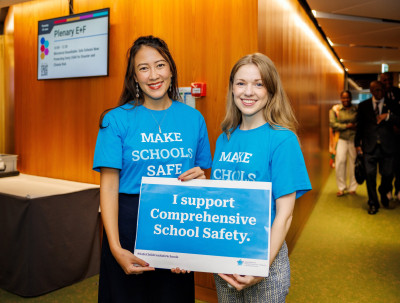
Image credit: Marc Bader
4. Disaster Risk Reduction actors are calling for safe schools.
The Geneva Call for Disaster Risk Reduction offers this political commitment. The document, which is the outcome of GP2025, recognises the importance of the Comprehensive School Safety Framework as a key way to protect children, education systems, and investments:
Risk-inform all investments: When disaster risks are ignored, even the most ambitious development projects are likely to fail. Public and private investments should be guided by a thorough understanding of disaster risk. For example, investment in the resilience of the education sector has a multiplier effect. Implementing the Comprehensive School Safety Framework will help protect children and youth from disasters.
We must now harness this political commitment to drive action at all levels.
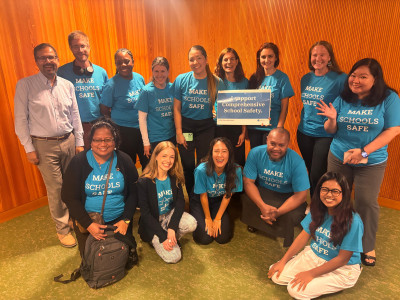
GADRRRES members at the official side event 'Inclusive Comprehensive School Safety: Strengthening Resilience for Children and Youth in all hazards.'
So what’s next?
As always, conferences are only as powerful as the action they ignite. Discussion must be a catalyst, not a conclusion.
GP2025 showed it’s time to join hands and efforts across sectors to drive school safety. We know what works, we have the mandate from the Geneva Call to Action, and we have the evidence we need to show that we need action, now.
GADRRRES encourages all governments and partners to endorse the Comprehensive School Safety Framework and use it to drive what comes next, including:
- Strengthening cross-sectoral work on school safety, establishing a national multi-stakeholder school safety coordination body.
- Integrating schools into efforts to establish Multi-Hazard Early Warning Systems for All, ensuring appropriate investment and training.
- Protecting education investments through allocating financing for Disaster Risk Reduction and resilience.
- Scaling up policy and infrastructure initiatives to build heat-resilient schools.
Finally, we must heed the call to action from Rio Ananda, youth activist from Indonesia, who said it best:
"Include us. Empower us. Work with us. Together, we can ensure every children and youth learns in a safe and resilient school."



